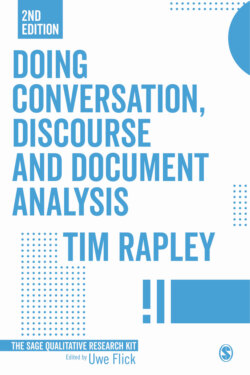Doing Conversation, Discourse and Document Analysis

Реклама. ООО «ЛитРес», ИНН: 7719571260.
Оглавление
Tim Rapley. Doing Conversation, Discourse and Document Analysis
Doing Conversation, Discourse and Document Analysis
Contents
List of illustrations. Boxes
Figure
Editorial Introduction
Introduction to The SAGE Qualitative Research Kit
What is qualitative research?
How do we conduct qualitative research?
Scope of The SAGE Qualitative Research Kit
About this Book and Its Second Edition
Acknowledgements
Chapter One Studying discourse. Contents
Chapter objectives
Some introductory thoughts
Some thoughts on origins
Some thoughts on what is to come
Key points
Chapter Two Generating an archive. Contents
Chapter objectives
Sources of ‘data’
Document-based sources
Some practical considerations when working on documents
Some closing comments on working with documents
Audio- and visual-based sources
The call for ‘naturally occurring’ data
Some closing comments
Key points
Chapter Three Ethics and recording ‘data’ Contents
Chapter objectives
Some ethical issues on making and recording research ‘data’
What is the background of the study?
Sitting and observing clinical appointments
Consent Form. Research consent form: Observation of consultations with a young person
Recordings in ‘public spaces’
Some closing comments
Key points
Chapter Four The practicalities of recording. Contents
Chapter objectives
Recording equipment
How do you know what to record?
The practicalities of interviews and focus groups. Recruiting participants
Generating a list of questions and topics
Recording
The practicalities of audio- or video-based ethnographies. Recruiting participants
Generating a list of questions and topics
Recording
Some closing comments
Key points
Chapter Five Transcribing audio and video materials. Contents
Chapter objectives
Introducing the recording
Describing the scene
A basic transcript
A question of detail
A Jeffersonian transcript
Working versus reporting transcripts
Working with video-based data
Transcribing images
Some closing comments
Key points
Chapter Six Exploring conversations. Contents
Chapter objectives
Exploring a mundane moment in talk
The interactional management of diagnosis in a hospital setting
The routine organization of social life
Turn-taking organization
Sequence organization and turn design
Lexical choice, category and epistemic work
Structural organization
An observation on an aspect of storytelling
Some observations on the social institution of refusal and disagreement
So what?
Some closing comments
Key points
Chapter Seven Exploring conversations about and with documents. Contents
Chapter objectives
Documents-in-use
Case study: How a psychiatric record was created
Case study: Reading from and reporting findings of a report
Case study: Making sense of a video recording in courtrooms
Some closing comments
Key points
Chapter Eight Exploring conversations and discourseSome debates and dilemmas. Contents
Chapter objectives
The hidden role of the analyst
Just focusing on brief moments of interaction
Working with the local contexts of focus group and interview data
Working with power (and other key concepts)
Some closing comments
Key points
Chapter Nine Exploring documents. Contents
Chapter objectives
Thinking about what is there (and not there)
Arguing the case
Expanding an argument
Whose problem, whose solution?
Thinking about the history of our present
Case study: The discovery of doctors’ ‘minds’ and ‘bodies’
The 1950s
The 1960s and 1970s
The 1980s and 1990s
Some closing comments
Key points
Chapter Ten Studying discourseSome closing comments. Contents
Chapter objectives
Coding, analyzing and thinking with your archive
Questions of quality and reflection
Steps and key points of analyzing conversations, discourse and documents
Some (final) closing comments
Glossary
References
Index
Отрывок из книги
Uwe Flick
In recent years, qualitative research has enjoyed a period of unprecedented growth and diversification as it has become an established and respected research approach across a variety of disciplines and contexts. An increasing number of students, teachers and practitioners are facing questions and problems of how to do qualitative research – in general and for their specific individual purposes. To answer these questions, and to address such practical problems on a how-to-do level, is the main purpose of The SAGE Qualitative Research Kit.
.....
For example, I became interested in why, when we visit the theatre, we all sit very quietly, become relatively immobile and condemn others (and sometimes feel anger towards others) for breaching these rules. I went to various archives and generated a collection of materials around the audience in London’s theatres. I learned that it is only in the recent past, over a period between the nineteenth and twentieth centuries, especially around the 1880s, that theatre-goers became increasingly ‘tamed’. Prior to this, audiences did things like shout at actors to repeat what they felt were well-delivered monologues, talked to their friends who had purchased the more expensive seats that were placed on stage, or threw food at actors whom they felt were ‘bad’. The shift from the more carnivalesque occurrences of past audiences to today’s docile assembly was mediated by various trajectories, including:
This research was made possible by using secondary sources – more ‘academic’ books and articles on the history of theatrical performance, design, production and ownership – and primary sources, such as nineteenth-century critics’ commentaries on certain productions and audience behaviour, actors and audience members’ diaries and letters, newspaper articles, debates in Parliament and theatrical trade publications.
.....